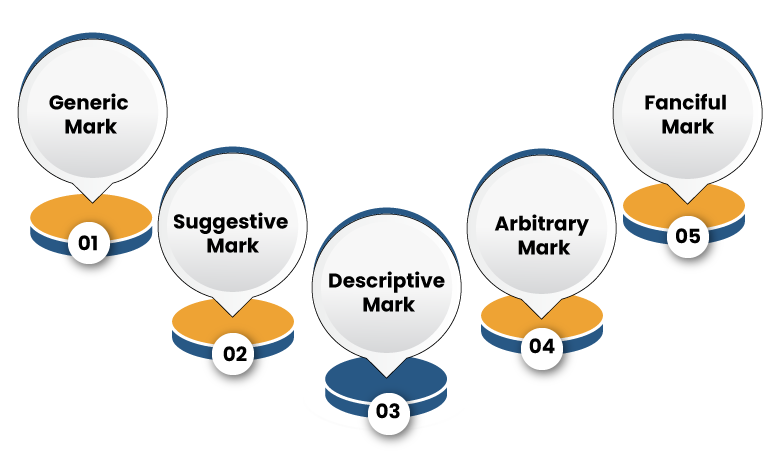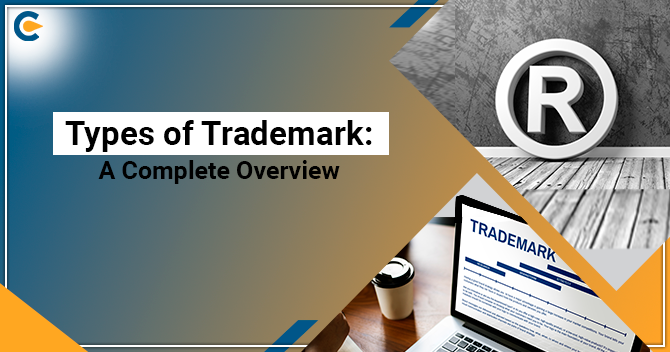As industries strive to gain a legal monopoly on their unique offerings via marks registration, we are flooded with the increasing number of products affixed with ™ and the ® marks. But what do these marks imply? This write-up will shed some light on the various types of trademarks that business owners can opt for.
It is indispensable to differentiate among several types of trademarks to pinpoint apt protection for a product or service. In negligence in this context would lead to costly legal disputes and cancellation of your trademark registration. Therefore, consulting with experts is of paramount importance in such scenarios, and it’s certainly a prudent decision.
The trademark symbol ™ & its iteration the ® fosters the sense the reliability and trust among the target masses—each brand, mainly bigger corporations, affixes their trademarks on their offerings available to the end-users.
Product trademarks are classified into five important categories. Marks could be generic, descriptive, arbitrary, or suggestive. Moreover, the 4th schedule of Trademark rules 2002 categorizes Trademark based on the product’s nature relative to a trademark under consideration. These are the categorization of goods & services under 45 distinct classes. However, only a few people know to pinpoint the exact purpose of the Trademark.
Classifying one from the other type of trademarks helps in clarifying which type to use for several cases. It aids to avert mistakes. Apart from preventing monetary losses, the stratification also manifests the corresponding degree of protection.
Common trademarks available to business owners in India


Generic marks
It manifests the general descriptions of a product or its seller. It could be general words such as watch or food or drink. But since these terms belong to the public, an eating house, for example, is not permitted to avail trademark protection. And rightfully so, as it would lead to a prejudiced monopoly over the entire food industry sector. Every other entity could hardly survive in such a scenario. Therefore, an entity ought to add another modifier to its products to register the generic mark.
Suggestive mark
The marks above are widely used, and hence it would take more than a general approach for the applicant to avail protection for such terms. Convincing authority on the uniqueness of the generic mark is the hardest part of the trademarking process. Unlike a generic mark, the suggestive mark is less straightforward, and it only signifies the key attribute of the product, but in a controlled way. It negates the complete manifestation of the product or services. The best example of suggestive Trademark is NetFlix and AirBus.
Descriptive mark
A descriptive mark refers to a mark that manifests some characteristics of the goods/ services. The description attribute could be quality, kind, quantity etc. Since such terms are deemed as a part of a global language, they are still eligible for trademark protection. Anyway, adding a signifier to suggest the product’s quality can help it avail trademark registration.
Arbitrary mark
Such types of trademarks excel on the words or phrases from the vernacular. Unlike suggestive marks, these terms indicate no association with the product they signify. Businesses using arbitrary marks often rely on aggressive marketing strategies to make their product recognizable in the target market. It is needless to mention such strategies lure considerable investment.
Fanciful mark
As the name suggests, fanciful marks have no dictionary meaning, but they can create a stronghold in the target market. Kodak is a primary example of a fanciful mark that indicates nothing in a literal sense but has an unprecedented recognition in the global market. Large organizations have a greater admiration for fanciful marks owing to their potency to foster a loyal customer base. The problem with Fanciful marks is that they are not explanatory and take a considerable amount of time to make their presence feel in the target market. Crafting a productive fanciful mark is a painful procedure for marketers and business experts. Considering the prevailing competition in the market, a lot of thought process goes behind the development of a fanciful mark. Fanciful marks are easy to register as compared to other marks.
Read our article:How Can You Apply For Online Trademark Registration in India?
Some additional trademarks frequently used in business space
Here are some vital trademarks that are aggressively used in the business space.
Service Mark
This type of Trademark ensures protection for services rather than products. While generally interchangeable in the vernacular, such marks differentiate an entity’s class of services from the rest of the others operating in the same domain. Examples include Indian Airlines, Taj Hotels, and Oyo to name a few.
Key takeaway:
Because it is inevitably difficult to quantify when contrasted with products, these marks seek a longer timeframe to process & generally entails more stringent evidential requirements.
Collective Mark
Collective Marks refer to a unique trademark hold by associations or organizations. The mark aims to distinguish organizational origin. For example, the Red Cross leverage a kind of marking to separate its services & members from identical institutions. Moreover, it deters others from using their mark.
Certification Mark
Such types of trademarks are used to ensure adherence to local norms. When contrasted with other marks, such a mark is utilized by a legalized user, not the owner. In addition to that, to underpin an additional layer of protection, these certifications avenues are not permitted to grant this mark for their own use.
Trade Dress
Trade dress refers to elements of the sensual or visual appeal of the product that includes its packaging, colour combination, shape, which may be protected from being utilized by rivals in relation to their services. The characteristic entails their shape, colour combination, packaging, graphic design to the product.
Trade Name
Trade names are utilized in identifying an entity as a whole instead of distinguishing a particular product or service. This is aggressively used in the bigger corporation dealing with a wide array of brands under their trade name. Proctor & Gamble (P&G) is a perfect example of a trade name that holds numerous marks, such as Oral-B.
House Mark
Just like trade names, such types of trademarks identify the manufacturing entity or OEM. But, the difference is that such marks are placed adjacent to product names to identify them as belonging to the entity. To clarify this point, we can take the Honda motor as an example. Launching car models such as “Honda Accord” and “Honda City” with their separate trade names makes them more recognizable.
Family of Marks
The Family of Marks is more or less similar to house mark. But, the primary difference exists in its form. Such marks excel on abbreviations and initials instead of a full name. A common example is the letter “i” from iPod, iPad, and iPhone, among others.
Sound Mark
Sound Mark is broadly known as Jingle, a distinctive sound that helps the brand attain a unique identity in the target market. iPhone is often recognized through their signature ringtone that differentiates them from the rest of the OEMs.
Position Mark
A position mark refers to non-conventional marks are used to identify the accurate positioning of a mark w.r.t its surrounding elements. For example, logos appearing on footwear are places utilizing the same proportions across the line of product. However, the positioning itself should be considered distinctive to the organization.
Pattern Mark
Such types of trademarks are widely found in the fashion sector. It safeguards the specific design tiled into a canvass. Imagine Louis Vuitton and its widely recognized pattern.
Hologram Mark
Hologram Mark is a one step forward in a visual communication technique. Lately, such marks have witnessed a massive utilization across all verticals of the industry. Hologram marks encompass the 3-D illustration shown in a holographic device.
Motion Mark
Unlike multimedia marks, such types of trademarks purely excel on the visual element only. It usually exists in the form of an animated logo that appears for a short time, once or in a loop.
Multimedia Mark
Multimedia marks are aggressively used in the film and TV Industry; they entail a visual sequence and sound elements. Netflix[1] utilizes the multimedia mark that protects its signature tone and animation logo that appears when users open the app.
Logotype
A logotype is a logo centred around an organization name or into initials. Such types of trademarks are also referred to as letter marks or wordmarks. Visa, Google and Coco-Cola are the few best examples of logotype trademarks.
Bottom line
The different type of trademarks mentioned above serves different purposes and excels on different legal aspects. They also play a vital role in strengthening the reputation of the brand, thereby ensuring growth for the company. For entrepreneurs, both emerging & established, knowing the criteria & degree of protection involved in each type would prove necessary in optimizing the IP portfolio.
Read our article:Trademark Renewal and Restoration in India











